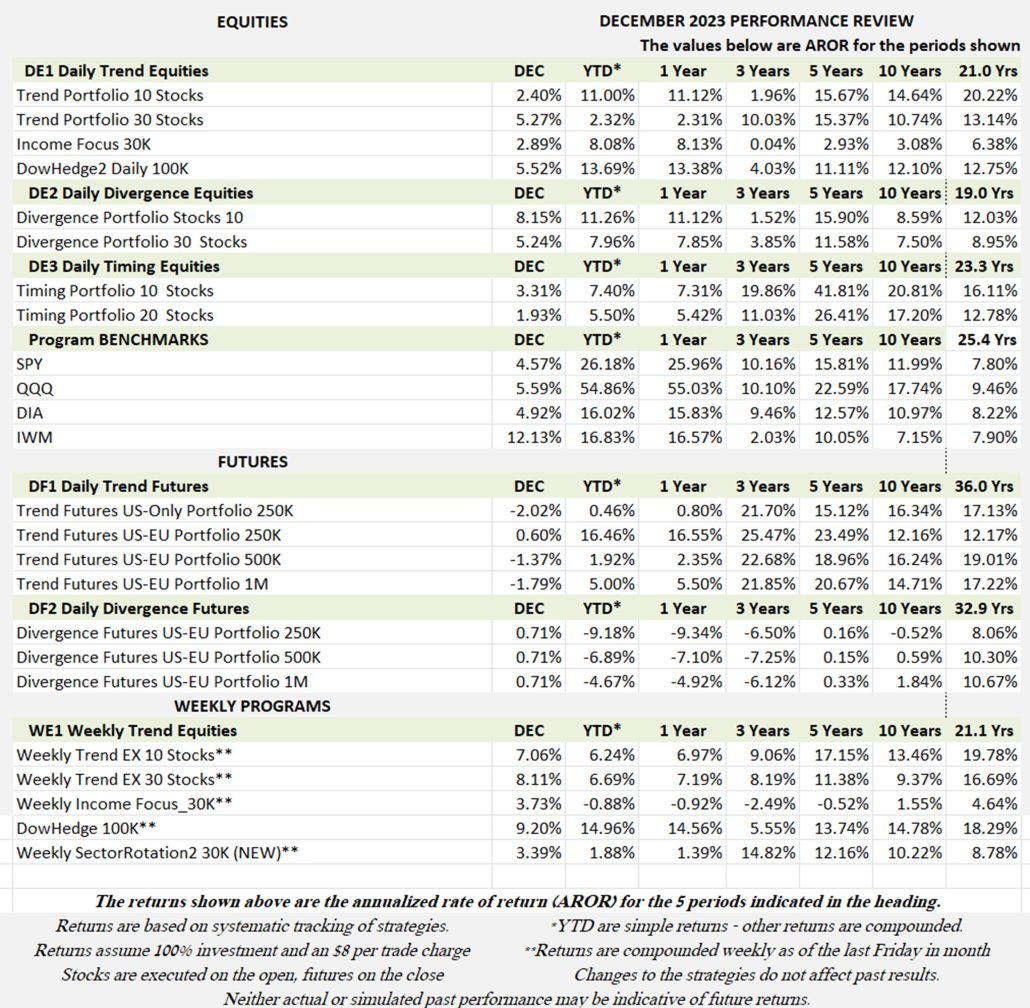
Industry Benchmark Performance
As of January 1, very few funds have posted performance. The CTA benchmark have a few entries, but the equity funds have none posted. The 2023 table shows performance through November.

Kaufman’sMost Popular Books (available on Amazon)
Trading Systems and Methods, 6th Edition. The complete guide to trading systems, with more than 250 programs and spreadsheets. The most important book for a system developer.
Kaufman Constructs Trading Systems. A step-by-step manual on how to develop, test, and trade an algorithmic system.
Learn To Trade. Written for both serious beginners and practiced traders, this book includes chart formations, trends, indicators, trading rules, risk, and portfolio management. You can find it in color on Amazon.
You can also find these books on our website, www.kaufmansignals.com.
Blogs and Recent Publications
Find Mr. Kaufman’s other recent publications and seminars at the end of this report. We post new interviews, seminars, and reference new articles by Mr. Kaufman each month.
December Performance in Brief
Gains in equity programs everywhere, putting the programs in positive territory for 2024. Yes, it looks like small returns compared to Nasdaq and even the S&P, but the market fooled everyone. We discuss that in our review for the year further down.
Futures failed to find trends, with most returns centered on shorts in interest rate futures, and a little in FX. Overall, the fight between traders and the Fed kept enough noise in the market to prevent any decent trends.
Given all that, we are pleased with the 2024 returns.
Major Equity ETFs
Two years, and all but the small cap (IWM) ETFs have made a new high. Remarkably, the other index ETFs seem to have achieved the same returns. It seems to be driven by a few stocks, but that can change once the general public decides that its safe to enter.
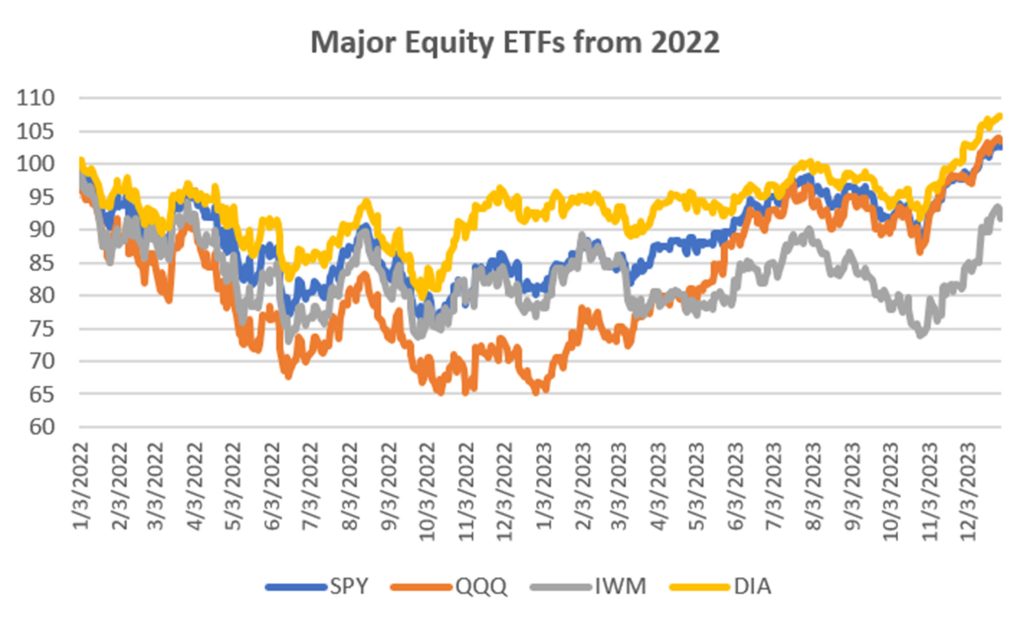
CLOSE-UP: The Year in Review
Normally, we would consider our 2023 performance as OK, with our benchmark 10-stock equities up 11%. 11% compounded makes a good investment. Other equity programs were similar, if a bit lower.
Futures depended on your investment. All portfolios were profitable, although not by much, except the $250K which returned 16%. That was all about timing.
But the financial news is all about the “magnificent 7,” Amazon, Apple, Google, Meta, Microsoft, Nvidia, and Tesla. The Nasdaq ETF (QQQ) was up 54% and the S&P (SPY) up 26%. Yet the funds, according to Barclays, had smaller returns than we did. And futures were also flat to negative. How can that be?
Sector Performance
Fidelity has a good table of sector performance that will explain the year. Technology has been the main driver, but consumer discretion is why we did not see the “predicted” hard landing.

Table 1. Fidelity Sector Performance. From the internet.
The Magnificent 7
Unfortunately, the news is all about hype. Financial reporters need a story to make the readers turn pages (or in this case “click”). So, naming these seven companies ‘the Magnificent 7” draws us in. But let’s look at them. Chart 1 shows the seven stocks starting from when META started, the last of the group.

Chart 1. The Magnificent 7, equally weighted, from when META started.
From 2012 to 2019 they performed nicely, but nothing special given the bull market. During the COVID pandemic, they prospered. But then, in 2022 they took a 50% loss. Now they have gained 110% (slightly more than the loss). But the low of the drawdown was about the 1st of January 2023, so this year had the perfect recovery.
Yes, I think they are good stocks and, yes, I think they will do well. But to ignore the drawdown and call them a wonderful investment is going too far.
TESLA
Personally, I think Tesla should be removed from this group. We all remember when it powered the market. But not anymore. Chart 2 shows the Tesla performance this year. It has gone up from about $100 to $250, a nice gain. But it is now stalled. To understand why, we can look at Chart 3, Lithium America.

Chart 2. Tesla returns in 2023.

Chart 3. Lithium America (LAAC).
Having reached above $10, LAAC has dropped to $5 before recovering. Or the same in Chart 4, Albemarle (ALB), a rare metals company with lithium as a product. Why the drop? It’s not the there is more lithium for batteries, but the all-electric cars have lost their shine. Demand is down, which affects both Tesla and Lithium. And China is trying to be the electric car king. I don’t believe that 2024 will show much of a recovery for Tesla.
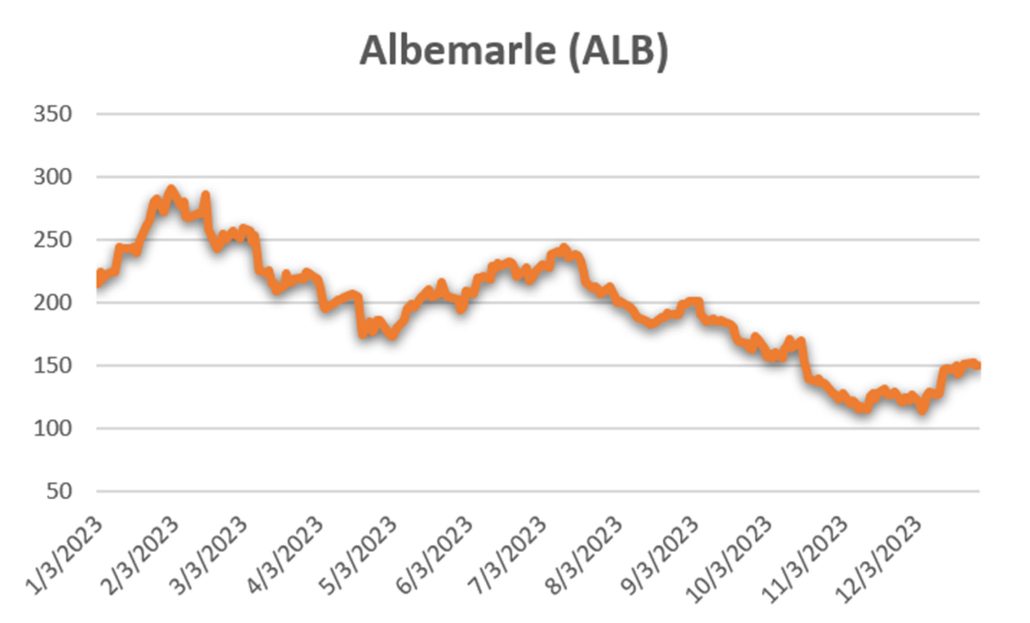
Chart 4. Albermare (ALB) in 2023.
Artificial Intelligence and Semiconductors
The interest in artificial intelligence is real. We will have software that uses what we now call ChatGTP, the ability to ask questions and get readable answers. The software scans “large data” to find answers. Most of the answers are correct, but not all. It seems that some lawyers have used AI to find cases to help their clients. But some of those cases did not exist! And we are warned that self-diagnosing yourself is not a good idea. Some of the data is obsolete.
With all that, we will still go forward. But like all stocks, even the best have ups and downs. Nvidia (NVDA) is the premier semiconductor company, but Chart 5 shows that it was not immune to the drawdowns in 2022. However, it has recovered nicely. It looks as though semiconductors designed for AI will be in demand in 2024.
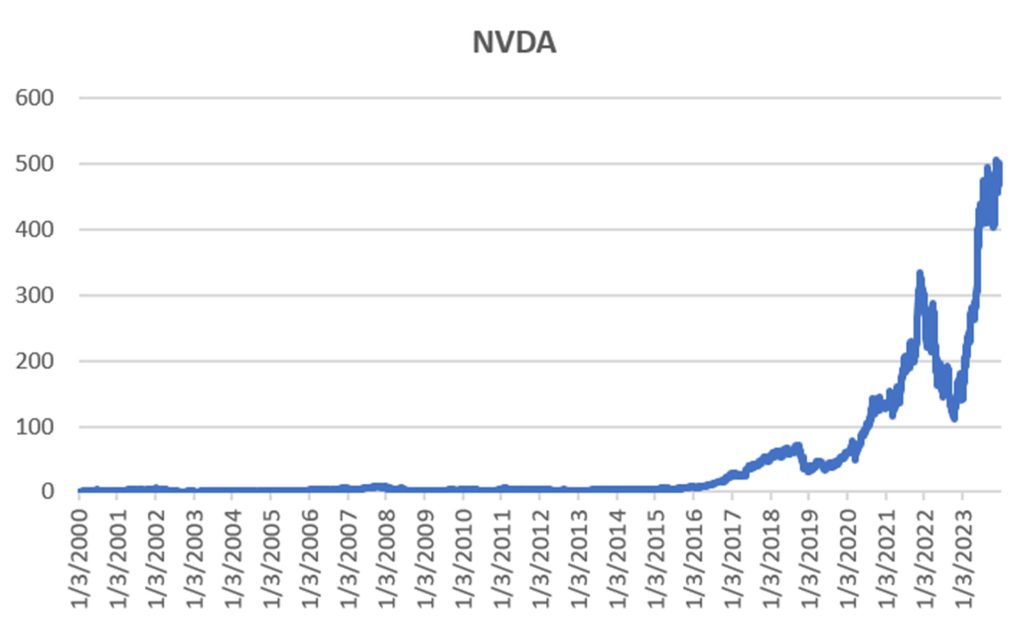
Chart 5. Nvidia (NVDA) from 2000.
Stock Picking
Picking a stock that performed well in 2021 (stay-at-home COVID) did not work in 2022. It is not surprising that funds were reluctant to jump back into those stocks in 2023. After a 50% drawdown, long-term trends would take a long time to reenter long positions. In our program, we are now long Microsoft, Meta, Nvidia, and Micron. We hope that AI will continue to dominate 2024, but no one knows for sure.
The Economy
The U.S. Federal Reserve (the “Fed”) was not much help this year. Yes, it has driven down inflation by raising rates steadily to 7%. And the consumers have weathered it, mostly because they see rates declining soon. And wages have increased, so at some point they will be ahead of inflation. Home owners are opting for variable rate mortgages, betting that this is the top.
Futures funds broke even this year. While the biggest moves were in interest rates, they required shorting (futures) as rates increased. That has not been a profitable strategy in the past. Rates rise, then fall quickly. It seems like an ideal pattern, but rarely generates a profit.
Eurodollars are the most likely candidate for profits. As you go further out on the maturity curve, patterns get noisy. Chart 6 shows nearest futures for SR3 (the new Eurodollars) and 30-Year Bonds. While Eurodollars are much smoother, it was also subject to a nasty move in March, a bad anticipation of the Feds policy. The trend for the long maturity did not turn down until the middle of the move, then lost most of the gains on the reversal.
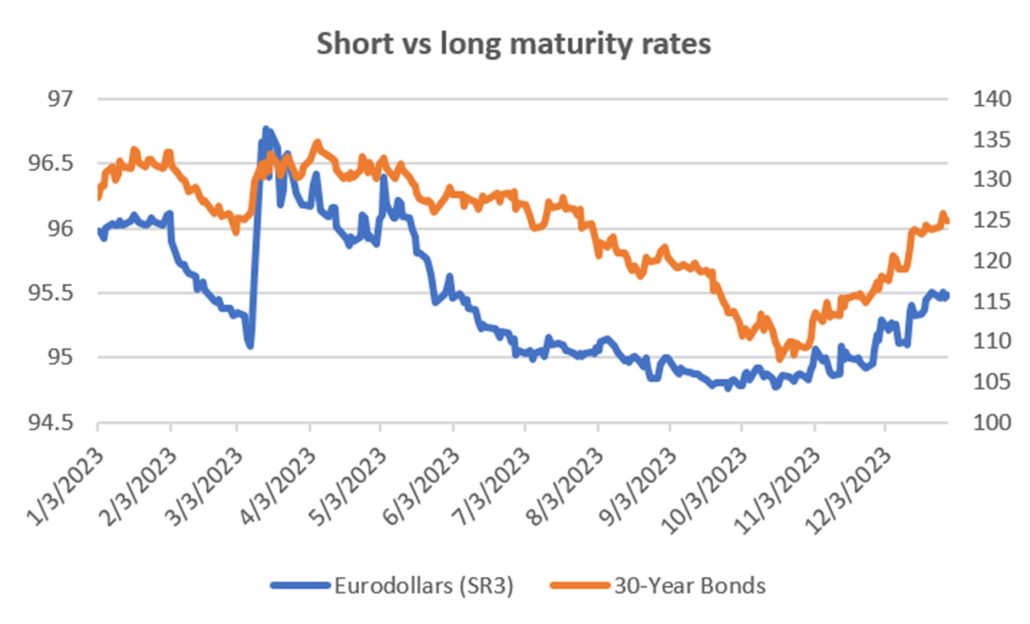
Chart 6. Interest rate futures, Eurodollars vs 30-Year Bonds.
Interest rates permeate other markets, particularly currencies. Chart 7 shows the EURUSD futures for 2023. Not much trend there, unless you’re a short-term trader. In the recent two months, the Euro gained over the dollar based on expectations of lower U.S. interest rates.
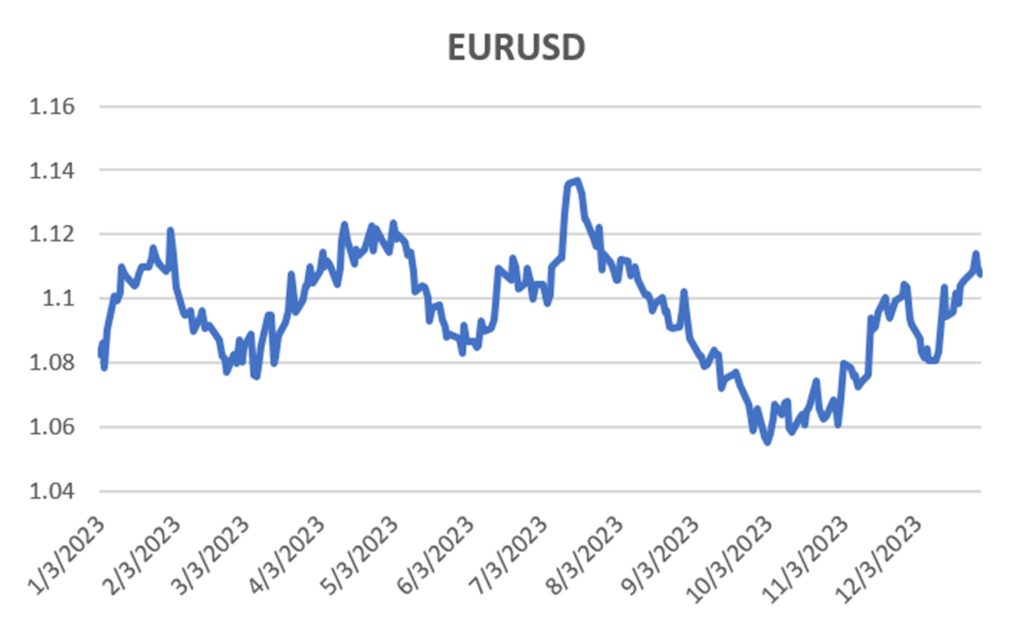
Chart 7. EURUSD nearest futures for 2023.
Gold is often an investors vehicle for hedging the declining dollar. There has been a lot of talk about gold reaching new highs. Chart 8 shows the futures price. Yes, it is moving above $2,000, but the pattern is both noisy and erratic. Again, a difficult market to capture a trend.
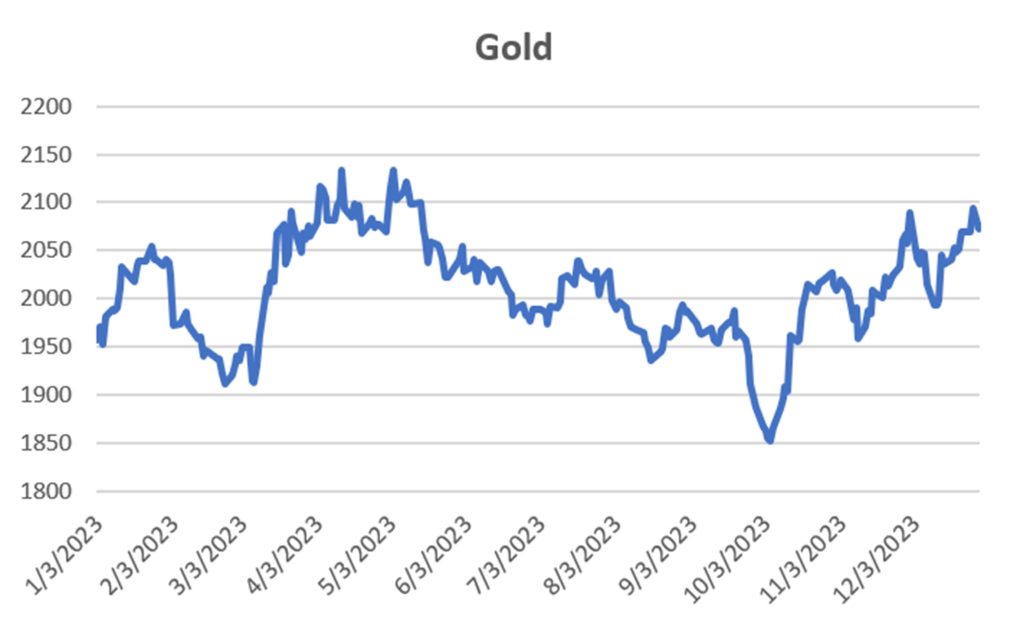
Chart 8. Gold nearest futures for 2023.
There is always energy, normally very volatile, but if you can stand it, highly profitable. With OPEC cutting output and with Russia seemingly boycotted, we would have expected crude oil to rise. Perhaps it did for two months in August and September. There is a lot of speculation about electric cars cutting the need for gas, or that the U.S. is now the largest producer, or that OPEC (as usual) cheats on its quotas. Whatever the reason, crude oil does not seem to be going anywhere, as can be seen in Chart 9.
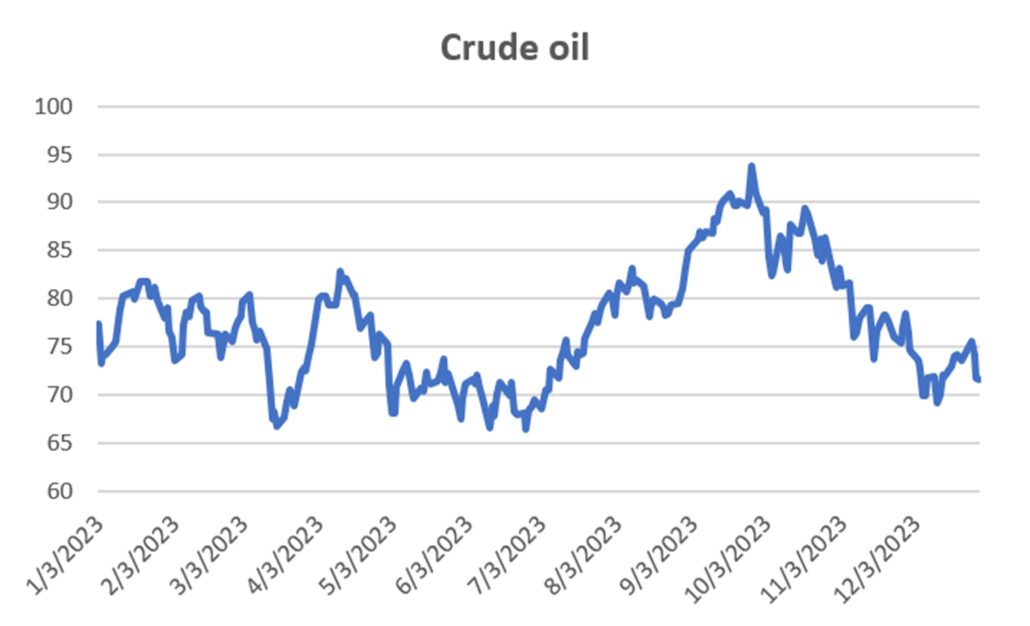
Chart 9. Crude oil nearest futures for 2023.
Our Own Performance
Chart 10 shows our Futures Trend portfolio for 2023 based on a $1 million account, which trades our broadest portfolio. I’ve taken the past returns and divided them by 23 to show a comparable performance. Short sales in Eurodollars and short-term rates carried the year. FX benefitted from the euro and somewhat from the yen. In futures, we can take long and short sales in the index markets, but the net was a loss, as was energy. The biggest loss was in metals, mostly gold and copper. Put it all together and it was a break-even year.

Chart 10. Our Futures Trend performance compared to the past.
Our Expectations for 2024
Interest rates will be the focus for the next few months, until the Fed decides to cut rates. The futures market tends to run ahead, then back off, the run ahead. It could be volatile.
Lower rates mean a lower dollar but a better economy. We can expect the dollar to decline, but not by much because foreign money will enter the U.S. to trade the stock market. And we can expect a rally in equities with investors waiting for the right opportunity to put their money back in the market. History shows that the typical investor has poor timing.
I can’t see that either gold or Bitcoin are relevant. Gold has not been a good store of value and I have no idea what causes Bitcoin to go up or down – no doubt buyers and sellers.
Then the best chances are to be long interest rate futures and long equities. But expect volatility. The “Magnificent 7” has not been a smooth ride, so keep some funds in reserve. And try to avoid anything owned by Elan Musk. It could rise, it could fall, but the price depends on his mood.
A Standing Note on Short Sales
Note that the “All Signals” reports show short sales in stocks and ETFs, even though short positions are not executed in the equity portfolios. Our work over the years shows that downturns in the stock market are most often short-lived and it is difficult to capture with a longer-term trend. The upwards bias also works against shorter-term systems unless using futures, which allows leverage. Our decision has been to take only long positions in equities and control the risk by exiting many of the portfolios when there is extreme volatility and/or an indication of a severe downturn.
PORTFOLIO METHODOLOGY IN BRIEF
Both equity and futures programs use the same basic portfolio technology. They all exploit the persistence of performance, that is, they seek those markets with good long-term and short-term returns on the specific system, rank them, then choose the best, subject to liquidity, an existing current signal, with limitations on how many can be chosen from each sector. If there are not enough stocks or futures markets that satisfy all the conditions, then the portfolio holds fewer assets. In general, these portfolios are high beta, showing higher returns and higher risk, but have had a history of consistently outperforming the broad market index in all traditional measures.
PERFORMANCE BY GROUP
NOTE that the charts show below represent performance “tracking,” that is, the oldest results since are simulated but the returns from 2013 are the systematic daily performance added day by day. Any changes to the strategies do not affect the past performance, unless noted. The system assumes 100% investment and stocks are executed on the open, futures on the close of the trading day following the signals. From time to time we make logic changes to the strategies and show how the new model performs.
Groups DE1 and WE1: Daily and Weekly Trend Program for Stocks, including Income Focus, DowHedge, and the new Sector Rotation
The Trend program seeks long-term directional changes in markets and the portfolios choose stocks that have realized profitable performance over many years combined with good short-term returns. It will hold fewer stocks when they do not meet our condition and exit the entire portfolio when there is extreme risk or a significant downturn.
A decent rally in December added 2.4% to 5.2% for the Daily program and 7% to 8% for the Weekly, giving these portfolios a positive 2023. Both 10-Stock portfolios (Daily and Weekly) could move to all-time highs if decide it’s time to join in.

Income Focus and Sector Rotation
Another good gain for the Income Focus program as rates start to decrease. Again, the daily program moved faster and gained more. Its 8% return is ahead of its 21 year average. The Weekly program is now flat for the year, but has not had the historic performance of the Daily portfolio.

Sector Rotation
Another good month for the Sector Rotation program, recovering from its losses to end the year higher. We need to than those underrated ETFs, Financials, Staples, and Utilities.

DowHedge Programs
A long awaited rally for the DowHedge program, gaining 5.5% for the Daily portfolio and 9% for the Weekly. That drives returns back to the top of the chart.

Group DE2: Divergence Program for Stocks
The Divergence program looks for patterns where price and momentum diverge, then takes a position in anticipation of the pattern resolving itself in a predictable direction, often the way prices had moved before the period of uncertainty.
With a trend developing, the Divergence strategy has a pattern that it can capitalize on. December showed a gain of more than 8% in the 10-stock and 5% in the 30-stock, ending the year higher by 11% and 8%.
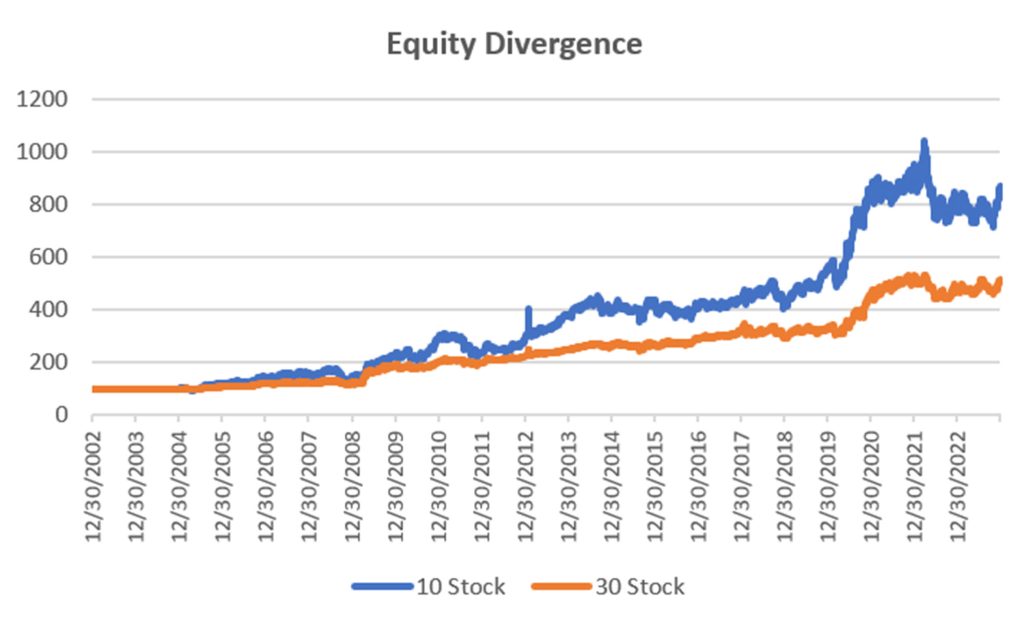
Group DE3: Timing Program for Stocks
The Timing program is a relative-value arbitrage, taking advantage of undervalued stocks relative to its index. It first finds the index that correlates best with a stock, then waits for an oversold indicator within an upwards trend. It exits when the stock price normalizes relative to the index, or the trend turns down. These portfolios are long-only because the upwards bias in stocks and that they are most often used in retirement accounts.
The Timing program has been quiet this year, not gaining much but holding onto positive returns. I find that a good performance profile. December added 3% and 2% to the portfolio for a net gain of 7.4% and 5.5% for 2024. It’s a good return for a difficult year.

Futures Programs
Groups DF1 and WF1: Daily and Weekly Trend Programs for Futures
Futures allow both high leverage and true diversification. The larger portfolios, such as $1million, are diversified into both commodities and world index and interest rate markets, in addition to foreign exchange. Its performance is not expected to track the U.S. stock market and is a hedge in every sense because it is uncorrelated. As the portfolio becomes more diversified its returns are more stable.
The leverage available in futures markets allows us to manage the risk in the portfolio, something not possible to the same degree with stocks. This portfolio targets 14% volatility. Investors interested in lower leverage can simply scale down all positions equally in proportion to their volatility preference. Note that these portfolios do not trade Asian futures, which we believe are more difficult for U.S. investors to execute. The “US 250K” portfolio trades only U.S. futures.
A disappointing return for the Futures Trend program (except for the 250K account). We explained earlier that trends were not clear in all but the short-term interest rate maturities. They made up for losses elsewhere. Still, all portfolios were positive, which was better than the average futures fund.

Group DF2: Divergence Portfolio for Futures
Not much to be excited here. The program ended with losses between 4% and 9%, gaining less than 1% in December. But it was out of the market most of the time, searching for a trade. As the market trends (we hope) in 2024, the program should be back on track.

Blogs and Recent Publications
Perry’s books are all available on Amazon or through our website, www.kaufmansignals.com.
January 2024
Perry posted 3 new articles on Seeking Alpha, “Where Do You Take Profits?”, “Is There a Better Day to Enter the Market,” and “Watching January Returns.”
Another article in Technical Analysis of Stocks & Commodities, “Gap Momentum,” another interesting way to identify the trend.
December 2023
Perry posted 3 new articles on Seeking Alpha, “Where Do You Take Profits?”, “Is There a Better Day to Enter the Market,” and “Watching January Returns.”
This month Technical Analysis of Stocks & Commodities published “A Strategy For Trading Seasonal and Non-Seasonal Market.” Turns out that most markets are non-seasonal!
November 2023
Perry posted two articles on Seeking Alpha, “Compression Breakout: Giving a Boost to Your Entries,” and “Volatility: The Second Most Important Indicator.” In addition, he interview Herb Friedman in Technical Analysis of Stocks & Commodities. Herb is a interest rate specialist focusing on low risk investments.
October 2023
In this month’s Technical Analysis of Stocks & Commodities Perry shows how Merger Arb works and how an investor can participate in it. Merger Arb has been the realm of Institutions, but there are opportunities for everyone.
August 2023
Two(!) new articles by Perry in the August issue of Technical Analysis of Stocks & Commodities. The first is a look at how ChatGPT might help traders. It even asks for a computer program to use trend following.
The second article is “Portfolio Risk Dilemma,” where Perry answers the question of whether to let a stock or futures profit run or rebalance, and whether you should do the same for a diversified portfolio.
June 2023
Another article in Technical Analysis, “Protecting Your Wealth While Making a Profit.” It shows that moving money into different world equity markets can take advantage of momentum in both price and exchange rates.
May 2023
A new post on Seeking Alpha, “Profiting From Green Energy – But Not EVs” on May 31. Shows which stocks are best for investing in energy given the moving targets.
April 2023
On April 18th, Perry gave a webinar to the Society of Technical Analysts (London) on how to develop and test a successful trading system. Check their website for more details, https://www.technicalanalysts.com..
The April issue of Technical Analysis of Stocks & Commodities published a new article by Perry, “Repatriation,” an interesting trading pattern used by FX traders but adapted for us “normal traders.”
March 2023
Perry was interviewed by Mark Ursell of Ursell of TradeInform on March 3. You can see it or listen to it on UTube https://www.youtube.com/watch?v=9gIlIIzngCk.
A new article by Perry, “Can Volume Predict Price?” in the March issue of Technical Analysis of Stocks & Commodities. You’ll need to read it to find out!
February 2023
The February 2023 issue of Technical Analysis of Stocks & Commodities published Perry’s article, “Do Small Price Changes Matter?” It tells you whether you should be ignoring those days when prices close up or down by a fraction.
Perry gave a webinar to Eduardo Lopez’ Robotrader students in Spain on Wednesday, February 8, noon (New York).
Older Items of Interest
Perry’s webinar on risk, given to the U.K. Society of Technical Analysts, can be seen using the following link: https://vimeo.com/708691362/04c8fb70ea
For older articles please scan the websites for Technical Analysis of Stocks & Commodities, Modern Trader, Seeking Alpha, ProActive Advisor Magazine, and Forbes. You will also find recorded presentations given by Mr. Kaufman at BetterSystemTrader.com, TalkingTrading.com, FXCM.com, systemtrade.pl, the website for Alex Gerchik, Michael Covel’s website, TrendFollowing.com, and Talking Trading.com.
In May 2021, Mr. Kaufman gave a 30-minute presentation, “Lagged Trends,” for The Money Show on Tuesday, May 11. You can see it using the following link: https://youtu.be/bh2fA8oBwBk
You will also find back copies of our “Close-Up” reports on our website, www.kaufmansignals.com. You can address any questions to perry@kaufmansignalsdaily.com.
© December 2023, Etna Publishing, LLC. All Rights Reserved.
